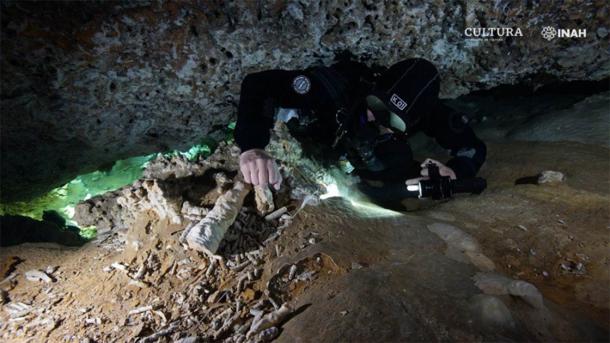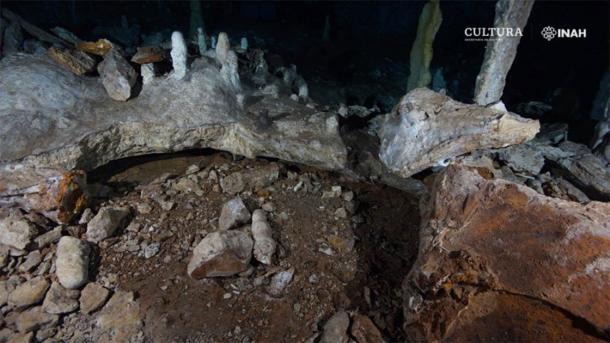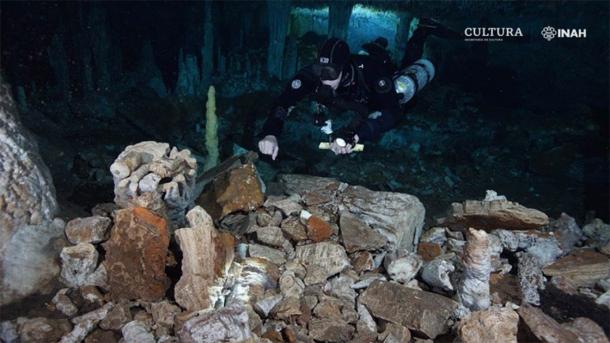
Divers Find Oldest Ocher Mines in the Americas
Experts in Mexico have discovered what they believe to be the oldest ocher mines in all the Americas. They date back an astonishing 10-12,500 years ago. The discovery is helping researchers to better understand the Paleoindian era and how highly valued the red pigment was for ancient societies.
The prehistoric mining operation was uncovered in a coastal cave system in Quintana Roo, Mexico, off the coast of the Yucatan Peninsula. This system was submerged under the waters during the Last Ice Age but was once part of the land.
In 2017 an international team of divers led by Brandi MacDonald under the auspices of the El Centro Investigador del Sistema Acuífero de Quintana Roo A.C. (CINDAQ) were exploring the underwater passageways. In one cave, they found features that could not be a result of natural processes and knew that they had found something special. INAH Cultura reports the divers were intrigued by ‘heaps of coal on the floor, the soot on the ceiling of the cave and most of all, the presence of small carved out cavities on the ground’.

America’s oldest ocher mine discovered in Quintana Roo. (Image: Sam Meacham, CINDAQ. A.C. SAS-INAH / INAH)
Ancient ocher pits
In 2018, with the help of an expert, they established that they had found evidence of an ocher mine. Over the following years, the team conducted many dives and retrieved samples and took photographs and videoed the site and other nearby sites. Then, divers brought their finds to the attention of Mexico’s Instituto Nacional de Antropología e Historia (INAH). They were able to use carbon dating to determine that the site was up over 12,000 years old.
The experts wrote in a study in Science Advances that, ‘The cave passages exhibit preserved evidence for ocher extraction pits’. Divers have named the site ‘La Mina’ and two later discoveries have been called ‘Camilo Mina’ and ‘Monkey Dust’. Eduard Reinhardt from McMaster University is quoted by Heritage Daily as stating that, ‘These underwater caves are a time capsule’. This is because many mines on the surface have been lost due to natural processes. The tools of the miners have also been uncovered and this is offering experts a unique opportunity to learn how ancient people’s mined ocher.
This ocher mine is easily the oldest yet found in all the Americas and one of the earliest sites of mining in all the Western Hemisphere. Brandi MacDonald told Heritage Daily that ‘What is remarkable is not only the preservation of the mining activity but also the age and duration of it’. The mining operation was very sophisticated as the team found evidence of navigational markers, in the form of stone cairns and many fires, presumably to provide light for the miners.

Mining tools were found in and around the many cavities of the cave. (Image: Sam Meacham, CINDAQ. A.C. SAS-INAH / INAH)
Before the rise of the Maya
It appears that the miners did not bring tools with them into the cave but used what they found in the underground. MacDonald from the University of Missouri, who led the analysis. “They’re breaking off stalactites from the ceiling and using them as hammerstones and pile drivers to smash through the limestone’ reports Science. Amazingly, it is believed that ocher was mined in the caves for around 2000 years, millennia before the rise of the Maya, Olmecs and other Mesoamerican civilizations.
Dr Roberto Junco Sánchez, a marine archaeologist with the Mexican Ministry of Culture that the site, ‘is a continuation of Hoyo Negro’ reports Cultura. This is an archaeological site where 10 Paleoindian skeletons were found. Among these was one known as ‘Naia’, which was a name given to the skeletal remains of a young woman found in 2014 inside the Hoyo Negro (Black Hole) archaeological site’ according to Cultura.
- A Mexican Underwater Cave System is the Largest in the World…and Filled with Archaeological Value
- First Americans Were More Diverse Than Thought
- Putting a Face to Eva of Naharon, The Oldest Human Relic Found in the Americas

Tulum, Quintana Roo. The labyrinthine subsurface of the Yucatan peninsula continues to be the source of scientific discoveries. (Image: Sam Meacham, CINDAQ. A.C. SAS-INAH / INAH)
Skeletons of Paleoindians
The remains of Naia and the others may be of those who entered the mines and even worked on them, although no human remains have yet been found in this area. The team of researchers have suggested that, ‘some miners may have died and been left where they perished’ according to Science News. It seems certain that the mining of ocher was abandoned because of the rising seas.
Further analysis has shown that the ocher was of high-quality and would have been very much in demand by artists. Science states that, ‘There’s no evidence to explain how the mine’s riches were used: The hot, humid jungle environment has decayed most archaeological clues. However previous studies can help researchers to understand the probable use of the pigment.
Ocher and human evolution
Ocher is an iron oxide earth mineral pigment that was used by ancient peoples all over the world and still used by many African tribes. ‘Considered to be a key component of human evolutionary development and behavioral complexity’ the experts wrote in Science Advances. It was highly prized, and it was used in rock art, body painting, tanning, adhesive and even as a bug repellent. Typically the pigment is believed to have been used in both ‘utilitarian’ or ‘ritual-symbolic’ contexts’’ according to Science Advances. Numerous examples of ocher grinding stones have been found throughout the world.
The fact that people were prepared to go deep underground illustrates how important ocher was for Paleoindians. MacDonald is quoted by Heritage Daily as stating that, “Our study reinforces the notion that ocher has long been an important material throughout human history.” Animals and plant remains have also been found in the caves and they are helping researchers to understand the environment of the earliest American ocher miners.
Top image: Diver Christophe Le Maillot documents the ocher mining activity at the site. Source: Sam Meacham, CINDAQ. A.C. SAS-INAH / INAH
By Ed Whelan















